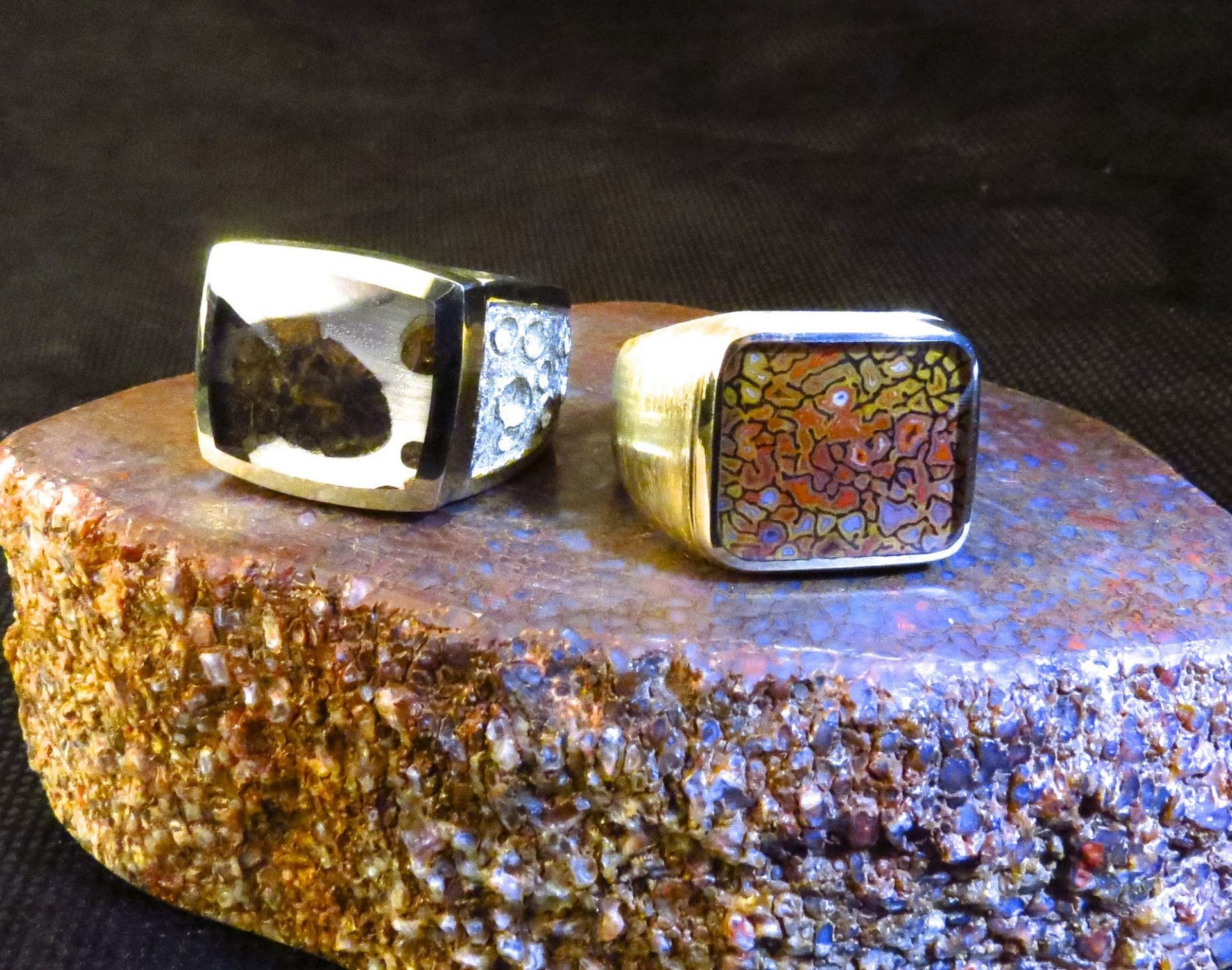
Unique Gem Materials for Jewelry Design
Some gems have an appeal beyond their appearance. If you’re looking for a gem with a story to tell, try these unique gem materials for jewelry design.
6 Minute Read
Fossils as Unique Gem Materials
Many people's experience with fossils is limited to museums and shark's teeth. However, some fossils make for great jewelry! Each fossil tells a unique story.
Dinosaur Bone
When most people think of fossils, they think of dinosaurs. The human fascination with these long-extinct beasts extends well beyond museums. Though the reconstructed skeletons are a sight to behold, when cut and polished, gem-grade bone makes a unique and colorful jewelry material. As the bone becomes fossil, minerals (often colorful agate) replace its cells. The resulting patterns make for interesting, unique jewelry pieces. Though most gembone is legal, smugglers sometimes transport this material across borders. Always purchase from a trusted seller to ensure that your gembone is legal.
Ammolite
Ammonites are marine molluscs that died out with the dinosaurs. Ammolite is gem-grade, iridescent ammonite shell, which occurs only in Late Cretaceous sediments in the Rocky Mountains. Made primarily of aragonite, the same material that's a main constituent of pearl, ammolite can display any color of the rainbow with bright iridescence. Intense red, orange, and green are the most common, but bright blue, yellow, and purple also occur. Quality factors include the number of colors seen, iridescence, and the degree to which the specimen can be rotated with visible color play. Ammolite jewelry will certainly receive many compliments.
Amber
Fossil tree sap, petrified over the last 30 million years or more, is another unique jewelry material. Pieces of amber containing insect remains are common collector's items, but specimens with rare insect species can hold high value. However, be aware that some dealers add modern insects to reconstituted amber to increase profits. Unless you're an entomologist who can tell the difference, make sure you deal with a trusted seller.
Toxic Gems
If you're looking for something with a touch of danger, a toxic gem may be right up your alley. Arsenic, lead, mercury, and hexavalent chromium are responsible for many deaths and environmental catastrophes. However, when handled safely and responsibly, the following unique gem materials may be cut and set into an assembled stone that's safe for wear.
For any toxic material, carefully review its Material Safety Data Sheet (MSDS) for recommended handling guidelines. While skin contact is fine for many substances, as long as you wash your hands, others are skin irritants or can be absorbed through the skin. Always avoid breathing in dust from these minerals, as particles can remain in your lungs and cause long-term health problems.
Realgar
Long used as a poison, realgar, or arsenic sulfide, is not something you want to ingest. While gem-quality material is rare and difficult to facet, realgar specimens with intense red to orange-red color do appear in some gem collections. With proper precautions, realgar could make an assembled jewelry stone. However, when handling this gem, avoid contact with water or steam, which can release toxic fumes. Furthermore, with a low melting point, avoid heat sources. Make sure to store realgar away from light, too, as this can cause the mineral to decompose into pararealgar.
Cinnabar
Faceted cinnabar looks like bright red candy, but tasting it is definitely not recommended. Ancient civilizations used cinnabar as a pigment, and many "cinnabar" items are, in fact, wood covered in a cinnabar lacquer. Since research has revealed mercury's toxicity, some jewelers have opted to coat wood with other red pigments to imitate this gem.
Crocoite
Red-orange to yellow-orange in color, this mineral can have bright, saturated color. Crocoite poses little danger from simple skin contact. Nevertheless, it's still a good idea to wash your hands after handling. As an assembled gem, its toxicity and softness won't be an issue for jewelry wear, and the bright color of this gem could shine.
Niccolite (Nickeline)
A double whammy, niccolite contains nickel and arsenic. It's highly toxic if inhaled, ingested, or comes in contact with your eyes. Prolonged skin contact isn't recommended, but normal handling should be safe as long as you wash your hands. This metallic mineral takes a beautiful polish and makes an excellent cabbing or carving material. A clear coat of nail polish will ensure that the niccolite stone isn't in contact with your skin. It has the added bonus of preventing tarnish from moisture exposure as well.
Unique Gem Materials from Space
Gem materials with extraterrestrial origins are rare here on Earth, our small speck of the universe. The rarity and natural beauty of meteorite make it a novel jewelry material. In addition, some gems form from meteorite impacts. While technically terrestrial, glass pieces that form in impact craters are lasting reminders that there's more to this universe than our pale blue dot.
Meteorite
Meteoroids are sometimes trapped by Earth's gravity and fall to the ground as meteorites. Their compositions can vary widely. Iron meteorites, comprising approximately 6% of meteorites, are most commonly used in jewelry. With an attractive Widmanstӓtten pattern arising from slow cooling in space, the texture of iron meteorite will certainly attract attention.
Meteorite and Wood Wedding Band by Jewelry by Johan. Licensed under CC By 3.0.
Most meteorites are silicate-rich and may contain minerals unknown on Earth. Though used less often in jewelry, slices and cabochons of these specimens can reveal the attractive minerals within.
Stony-metal meteorites occur more rarely and have beautiful silicate minerals surrounded by an iron matrix. Though valued for its scarcity, this material may pose a challenge during polishing.
Carbonado Diamonds
More durable than most diamonds, carbonado diamonds are highly unusual. These porous aggregates of black diamond, amorphous carbon, and graphite occur only in Brazil and the Central African Republic, which were once adjacent areas of the supercontinent Rodinia. Geoscientists are still debating the mechanism of their formation, though an extraterrestrial source is likely. These polycrystalline diamonds are unlike anything else on Earth. Though rarely large enough for faceting and with typically pitted surfaces, they'll still fascinate as one of the rarest materials on the planet.
Tektite
Although some believe tektites have extraterrestrial origins, these natural glasses are most likely terrestrial. Tektites form when a high-velocity meteorite impact melts and ejects material back into space, which cools upon re-entering the atmosphere. These gems can be black, gray, brown, or green. Highly popular moldavites from the Nördlinger Ries impact crater in Germany, which flung material into the Czech Republic, have an attractive olive green color.
Viking Sun Stone
During sea voyages, Vikings navigated by the Sun. However, cloudy days made it difficult to find its exact position. Historical records mention use of a "sun stone" to do just that. Researchers believe that it was either iolite, a strongly pleochroic gem whose violet-blue hues can sometimes rival fine sapphire, or Iceland spar, another name for rhombohedral calcite. (It's likely not the gemstone known in modern times as sunstone).
Unusual Mineral Habits as Unique Gem Materials
Sometimes the form that a mineral takes falls outside of most people's expectation of what a rock can be. Flexible palygorskite, with the nickname "mountain leather," is one example. Millerite, with a hair-like mineral form, is another. While these unusual minerals rarely make their way out of a mineral cabinet, a creative designer could make use of these unique gem materials to make something the world has never seen.
Related Articles
Tektite Value, Price, and Jewelry Information
Amber Value, Price, and Jewelry Information
Ammolite Value, Price, and Jewelry Information
Crocoite Value, Price, and Jewelry Information
Latest Articles
800 Years of Mogok: A Celebration in Tenuous Times
What is the Average Gemstone Faceting Yield?
Pyroxmangite Value, Price, and Jewelry Information
How to Identify Emerald Simulants and Synthetics
Never Stop Learning
When you join the IGS community, you get trusted diamond & gemstone information when you need it.
